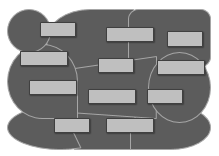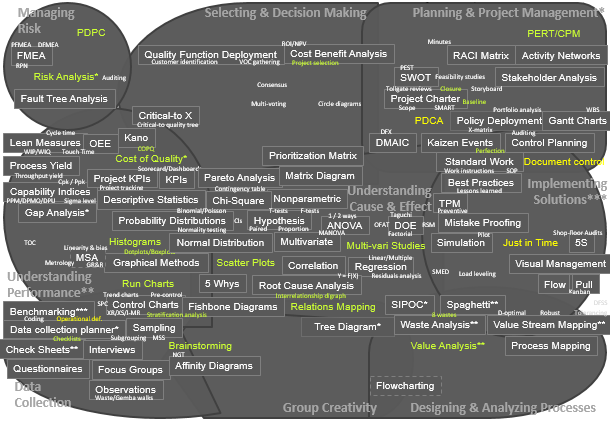Latest update: June 2022
A Six Sigma Black Belt is an experienced professional capable of initiating and executing large-scale, cross-functional Lean Six Sigma projects. They should know how to apply advanced techniques and statistical methods. Furthermore, they should demonstrate a comprehensive understanding of team dynamics and should have the ability to instruct and guide Green and Yellow Belts. A Six Sigma Black Belt should demonstrate understanding and competence in using the tools illustrated in the following map.



Topics
The Certified Six Sigma Black Belt Body of Knowledge (BoK) also includes the following topics which are required for the certification exam (SSBB):
- Aligning Six Sigma objectives with organizational goals.
- Contingency and business continuity planning.
- Leadership roles and responsibilities.
- Common causes of Six Sigma failure.
- Readiness assessments.
- Communication plans.
- Six Sigma impact on stakeholders.
- Customer and financial measures.
- Hard cost measures and soft cost benefits.
- Team types and constraints.
- Team roles and responsibilities.
- Selection of team members.
- Elements necessary for successful teams.
- Team motivation.
- Team communication.
- Stages of team development.
- Team leadership models.
- Conflict resolution techniques.
- Meeting management.
- Team decision making methods.
- Implement an effective training.
- Effective training delivery.
- Training evaluation techniques.
- Business case justification.
- Project problem statement.
- Periodic project charter review.
- Qualitative and quantitative data.
- Continuous and discrete data.
- Measurement scales.
- Measurement systems across the organization.
- Metrology.
- Population parameters and sample statistics.
- Central limit theorem.
- Valid statistical conclusions.
- Capability studies.
- Process capability for attribute data and non-normal data.
- Transformation techniques.
- Process performance vs. specification.
- Sort-term vs. long-term capability.
- Correlation and causation.
- Statistical vs. practical significance.
- Point and interval estimates.
- Tests of means, variances and proportions.
- Developing plans to implement improvements.
- Evaluate results to select the optimum solution.
- Rational subgrouping.
- Common and special causes.
- Training for process owners and staff.
- Ongoing evaluation of the improved process and continuing process measurement.

Tools
Here are examples of the tools that are taught in any Six Sigma Black Belt training:
- Kano analysis
- Project charter
- Process mapping
- Process yield measures
- Descriptive statistics
- Normal distribution
- RACI matrix KPIs
See all our downloadable PDFs which only cover the tools part of the Black Belt Certification. The other topics can be found on the left side of this web page.
For comprehensive details on exam preparation and certification application processes, please refer to the official Black Belt webpage on the website of the American Society for Quality.

